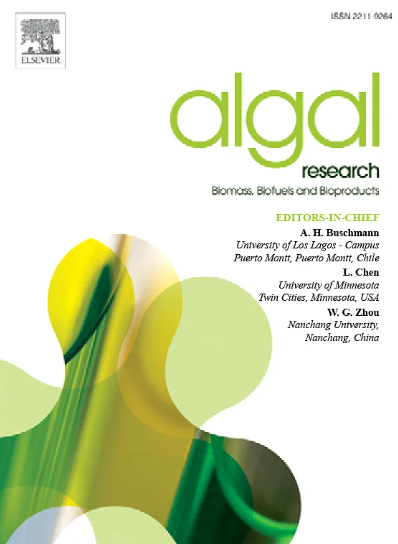来自螺旋藻的SARS-CoV-2 Mpro及其抑制肽:制备、鉴定、体外及活性和结合的硅表征
IF 4.6
2区 生物学
Q1 BIOTECHNOLOGY & APPLIED MICROBIOLOGY
Algal Research-Biomass Biofuels and Bioproducts
Pub Date : 2025-02-07
DOI:10.1016/j.algal.2025.103955
引用次数: 0
摘要
抑制SARS-CoV-2主蛋白酶(Mpro)的生物活性可有效阻止病毒复制,从而为2019冠状病毒病(COVID-19)干预提供了一个有希望的治疗靶点。本研究旨在筛选天然营养补充剂螺旋藻(Spirulina platensis)中Mpro抑制肽。首先,在大肠杆菌中成功制备了Mpro,并检测了Mpro的活性。同时,通过酶解得到了四种不同的蛋白肽。随后,合成了高活性肽,并通过体外实验和计算机模拟验证了其对Mpro的抑制作用。结果表明,该蛋白提取率为96.11%,Mpro活性为845.90 U mg−1,在2 mmol L−1浓度下,MQGPNY肽段对Mpro活性的抑制率为20.21%±3.8%。此外,计算机模拟结果表明,肽MQGPNY与Mpro形成四对氢键,分别为Gln189、Ser46、Thr26和Glu166。此外,还有10个自由残基参与疏水接触,包括His164、His41、Thr24、Met49、Thr45、Thr25、Gly143、Asn142、Cys145和Met165。本研究结果可为后疫情时代在功能食品和保健品配方中使用白僵菌蛋白及其水解产物提供理论支持。本文章由计算机程序翻译,如有差异,请以英文原文为准。
SARS-CoV-2 Mpro and its inhibitory peptides from Spirulina platensis: Preparation, identification, in vitro and in silico characterization of activity and binding
Inhibition of the biological activity of SARS-CoV-2 main protease (Mpro) effectively prevents viral replication, thereby presenting a promising therapeutic target for Corona Virus Disease 2019 (COVID-19) intervention. This study aims to screen the Mpro inhibitory peptides from the natural nutritional supplement Spirulina platensis (S. platensis). Firstly, Mpro was successfully prepared by heterologous expression in E. coli and Mpro's activity was detected. Meanwhile, four distinct peptides derived from S. platensis were obtained through enzymatic hydrolysis of protein. Subsequently, highly active peptides were synthesized and their inhibition effects on Mpro were verified by in vitro experiment and computer simulations. Results showed that the extraction rate of the protein from S. platensis was 96.11 %, the activity of Mpro was 845.90 U mg−1, the peptide MQGPNY could inhibit the activity of Mpro at the inhibition rate of 20.21 % ± 3.8 % at the concentration of 2 mmol L−1. Furthermore, results from computer Simulation showed that the peptide MQGPNY forms four pairs of hydrogen bonds with Mpro, which are Gln189, Ser46, Thr26 and Glu166. In addition, there were ten free residues involved in hydrophobic contacts, including His164, His41, Thr24, Met49, Thr45, Thr25, Gly143, Asn142, Cys145 and Met165. The foundings could provide theoretical support for the use of protein and its hydrolysates from S. platensis in functional food and supplement formulations in the post-epidemic era.
求助全文
通过发布文献求助,成功后即可免费获取论文全文。
去求助
来源期刊

Algal Research-Biomass Biofuels and Bioproducts
BIOTECHNOLOGY & APPLIED MICROBIOLOGY-
CiteScore
9.40
自引率
7.80%
发文量
332
期刊介绍:
Algal Research is an international phycology journal covering all areas of emerging technologies in algae biology, biomass production, cultivation, harvesting, extraction, bioproducts, biorefinery, engineering, and econometrics. Algae is defined to include cyanobacteria, microalgae, and protists and symbionts of interest in biotechnology. The journal publishes original research and reviews for the following scope: algal biology, including but not exclusive to: phylogeny, biodiversity, molecular traits, metabolic regulation, and genetic engineering, algal cultivation, e.g. phototrophic systems, heterotrophic systems, and mixotrophic systems, algal harvesting and extraction systems, biotechnology to convert algal biomass and components into biofuels and bioproducts, e.g., nutraceuticals, pharmaceuticals, animal feed, plastics, etc. algal products and their economic assessment
 求助内容:
求助内容: 应助结果提醒方式:
应助结果提醒方式:


